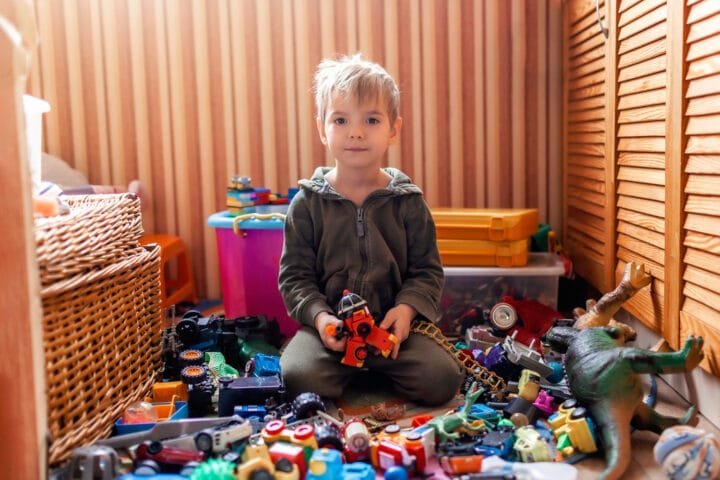Common Childhood Illnesses: A Parent’s Guide to Symptoms and Treatment
Decoding the Symphony of Sniffles, Sneezes, and Stomach Aches
Have you ever felt that sinking feeling when your little one’s cheerful laughter turns into a whimper, their rosy cheeks flushed with fever? All of us have been there. We’re wired as parents to worry, but knowledge is our superpower. By understanding common childhood illnesses, we can transform from anxious observers to informed caregivers. This comprehensive guide has to know many things about coughs, rashes, and tummy troubles in this control. Navigating those inevitable sick days is easier and more enjoyable when you know how to do it. The calmer the parent is, the more relaxed the child is, and who wouldn’t want less drama among thermometer readings and medications?
Respiratory Illnesses: When Breathing Becomes a Battle
Respiratory illnesses are the leading cause of child doctor visits. These conditions affect the airways, from those tiny noses to the delicate branches of their lungs. Let’s look at the most common culprits.
The Common Cold
It’s called “common” for a reason. The average child catches 6 to 8 colds yearly, each a whirlwind of sniffles, congestion, coughs, and sore throats. A low-grade fever might appear, and viruses cause most colds and resolve within 7 to 10 days. Treatment focuses on symptom relief and comfort. Ensure your child gets plenty of rest, offer fluids like water and electrolyte drinks, and consider over-the-counter medications to ease congestion or soothe a sore throat. Humidifiers can also loosen mucus and ease breathing.
- Did you know? Colds are most contagious in the first few days of symptoms. Chewing your child to cover their mouth and nose when coughing or sneezing and encouraging frequent handwashing can help prevent these pesky viruses.
Influenza (Flu)
Unlike its milder cousin, the common cold, the flu often strikes with a vengeance. High fever, chills, body aches, and fatigue accompany the usual cough and sore throat. Influenza can lead to serious complications like pneumonia, especially in young children and those with underlying health conditions. Treatment involves rest, hydration, and sometimes antiviral medications your doctor prescribes. But the most effective offense is better defense: the annual flu vaccine! It significantly reduces your child’s risk of flu. It can lessen the severity of the illness if they catch it.
- Fact: The flu vaccine is recommended for all children over six months of age. It’s updated yearly to match circulating flu strains, making protecting your child’s health essential.
Bronchiolitis
This illness affects babies and toddlers, causing inflammation and congestion in the lungs’ small airways. You might notice your child struggling to breathe, with rapid breathing, wheezing, and a persistent cough. Feeding can become difficult as breathing takes priority. While most bronchiolitis cases are mild and resolved with home care, some children, especially infants under six months, may require hospitalization for supportive care like oxygen therapy and mucus suction.
- Important Note: Bronchiolitis is often caused by the Respiratory Syncytial Virus (RSV). Premature babies and those with underlying heart or lung conditions are at a higher risk of severe illness. If your child is struggling to breathe or shows signs of dehydration, seek immediate medical attention.
Gastrointestinal Illnesses: Navigating Tummy Troubles Ups and Downs
Gastrointestinal illnesses can turn a happy tummy into distress. Vomiting, diarrhea, and abdominal pain are common symptoms, often caused by viruses, bacteria, or even food sensitivities. Let’s explore the most common gastrointestinal problems:
Gastroenteritis (Stomach Flu)
Gastroenteritis, often mistakenly called the “stomach flu,” is a common cause of vomiting and diarrhea in children. Most often, it is caused by a virus that causes abdominal cramps, fever, and general discomfort. Gastroenteritis is characterized by dehydration, which can happen quickly in young children. The treatment focuses on rehydrating your child with oral rehydration solutions (ORS). The E-solutions contain the right balance of electrolytes to replace those lost through vomiting and diarrhea. Offer small, frequent sips of ORS, and encourage your child to rest. A diet of easy-to-digest foods like crackers, toast, and bananas can help them as they start to feel better.
- Did you know? Rot virus is a common cause of severe gastroenteritis in young children. For unity, there’s a vaccine that protects against this virus!
Constipation
While not as dramatic as vomiting and diarrhea, constipation can cause significant discomfort in children. Frequent bowel movements, difficult stools, and abdominal pain are telltale signs. Encouraging a fiber-rich diet, ensuring adequate fluid intake, and increasing physical activity can regulate bowel movements. In some cases, your doctor may recommend stool softeners or other treatments.
- Fact: Constipation affects nearly 30% of children worldwide. Various factors, including diet, lack of exercise, and stress can cause it.
Childhood Diseases: Understanding and Preventing Through Vaccinations
Vaccinations have dramatically reduced the incidence of many serious childhood diseases. While these illnesses are less common today, it’s still critical to recognize their symptoms and understand vaccination’s importance:
Chickenpox
Nearly every child experienced this itchy rash with signature blisters before the vaccine. Chickenpox also causes fever and fatigue. Itching can be relieved with over-the-counter creams or lotions, while fever can be managed with acetaminophen or ibuprofen. In some cases, antiviral medication may be necessary, especially for children at risk of complications.
- Did you know? The chickenpox vaccine is highly effective at preventing the disease. If a vaccinated child gets chickenpox, the illness is usually milder.
Measles
Measles is highly contagious and starts with a fever, cough, runny nose, and red, blotchy rash that spreads from the face down the body. Tin-white spots inside the mouth, called Koplik’s spots, are distinctive signs of measles. Treatment focuses on managing fever and keeping the child comfortable. Measles can lead to serious complications like pneumonia and encephalitis (brain inflammation), highlighting the importance of vaccination.
- Fact: Measles is so contagious that 9 out of 10 unvaccinated people exposed to the virus will become infected. The measles vaccine is highly effective and safe, providing lifelong protection.
The Mumps
The Mumps is characterized by swollen salivary glands, which give children a “chipmunk cheek” appearance. There are also fevers, headaches, and muscle aches associated with the illness. Patients are treated with supportive measures, focusing on managing symptoms and ensuring adequate fluid intake. As a result, vaccination is crucial to prevent complications like meningitis (inflammation of the membranes around the brain and spinal cord) and hearing loss.
- Do you know this? The MMR vaccine protects against measles, mumps, and rubella. Typically, it is given in two doses, at 12-15 months and 4-6 years of age.
Other Common Illnesses: Earaches, UTIs, and More
Beyond respiratory and gastrointestinal illnesses, children frequently experience other common ailments:
Ear Infections
Ear infections are incredibly common, especially in young children, due to the anatomy of their Eustachian tubes. The E-tubes connect the middle ear to the back of the throat and drain fluid. When these tubes become blocked or inflamed, fluid builds up, leading to an ear infection. Symptoms include ear pain, fever, irritability, and sometimes drainage from the ear. It is painful, but most ear infections resolve on their own. Your doctor may prescribe antibiotics in certain cases, especially if the disease is severe or doesn’t improve within a few days. Pain relief is essential during healing.
- Fact: About 80% of children will have at least one ear infection by age 3. Factors that increase the risk of ear infections include exposure to secondhand smoke, attending daycare, and using a pacifier.
Urinary Tract Infections (UTIs)
Occur when bacteria enter the urinary tract, causing inflammation and infection. Children with UTIs experience painful urination, frequent urination, fever, and abdominal pain. UTIs require prompt antibiotic treatment to prevent kidney disease. Encourage your child to drink plenty of fluids to flush out bacteria.
- Did you know? UTIs are more common in girls than in boys. Encourage girls to wipe from front to back after using the bathroom. This is to prevent bacteria from entering the urethra.
Skin Infections: Rashes, Itches, and More
Children’s skin is delicate and prone to infections. Here are some common culprits:
Impetigo
This highly contagious bacterial infection causes red sores that quickly burst and form honey-colored crusts. Impetigo usually affects the skin around the nose and mouth but can appear anywhere. Treatment involves antibiotics, topical or oral.
- Fact: Impetigo is most common in children aged 2 to 5 years. Scratches can spread infection, so keeping your kids’ nails short and clean is critical.
Ringworm:
Despite its name, ringworm isn’t caused by a worm. Fungal infections cause a red, itchy, ring-shaped rash. Ringworm affects the scalp, body, and feet (athlete’s foot). Treatment involves antifungal creams or oral medications.
- Did you know? Ringworm is highly contagious and can be spread through direct contact with an infected person or animal or by touching contaminated objects.
Hand, Foot, and Mouth Disease
This viral illness causes a rash on the hands and feet and sores in the mouth. A sore throat also accompanies the rash. There is no specific treatment for hand, foot, and mouth disease. However, supportive care like pain relievers and cooling fluids can help manage symptoms.
- Fact: Hand, foot, and mouth disease is most common in young children and spreads easily in daycare and school settings.
Fever: Decoding the Body’s Alarm System
Fever is a common symptom of childhood illnesses. It is the body’s natural response to infection, signaling that the immune system is fighting off invaders. A fever isn’t usually harmful but can make your child uncomfortable.
When to worry
Generally, a fever below 100.4°F (38°C) doesn’t require treatment unless your child is uncomfortable. For fevers above 100.4°F, you can give acetaminophen or ibuprofen (always follow the recommended dosage for your child’s age and weight). See medical attention if your child has a fever that lasts longer than three days, is accompanied by other concerning symptoms (like a stiff neck, severe headache, or difficulty breathing), or if your child is younger than three months old and has a rectal temperature of 100.4°F or higher.
- Did you know? Febrile seizures can occur in children with high fevers. While frightening, these seizures are usually harmless and harmless.
Dehydration: Recognizing the Signs and Taking Action
Dehydration happens when the body loses more fluid than it absorbs. This can occur with illnesses that cause vomiting, diarrhea, or sweating. De duration can become serious quickly in children, so it’s imperative to recognize the signs:
Signs of dehydration
Watch for decreased urination, dry mouth and tongue, sunken eyes, no tears when crying, and lethargy. A sunken fontanel (soft spot on the head) can also indicate dehydration in infants.
Treating dehydration
Offer your child frequent sips of oral rehydration solution (ORS). If your child vomits, offer small amounts of ORS frequently. Avoid sugary drinks like juice and soda, as these can worsen diarrhea. If your child shows signs of severe dehydration or cannot keep fluids down, seek immediate medical attention.
- Fact: Dehydration is a leading cause of hospitalization worldwide. Treatment of patients with ORS can prevent serious complications.
Home Care Strategies: Easing Discomfort and Promoting Healing
While many childhood illnesses resolve on their own, there’s plenty you can do at home to help your child feel better and promote healing:
- Rest: Encourage your child to rest as much as possible. This helps the body conserve energy and focus on fighting infection.
- Hydration: Offer fluids like water, electrolyte drinks, and diluted juice. Avoid sugary beverages, which can worsen diarrhea.
- Comfort measures: A cool compress on the forehead can reduce fever. Saline drops, or a humidifier can ease congestion. Soothe a sore throat with warm liquids like soup or tea (avoid honey for children under one year old).
- Over-the-counter medications: Acetaminophen or ibuprofen can reduce fever and relieve pain. Always follow the recommended dosage for your child’s age and weight. Cough and cold medications are generally not recommended for young children.
- Please note: Always consult your doctor before giving your child any medication, including over-the-counter products.
When to Seek Medical Attention: Trust Your Instincts
As a parent, you know your child best. Trust your instincts and seek medical attention if you’re concerned about your child’s health. Here are some situations where doctors are important:
- High fever: A fever that lasts longer than three days, is higher than 104°F (40°C) or is accompanied by other concerning symptoms like a stiff neck, severe headache, or difficulty breathing.
- Difficulty breathing: Rapid breathing, wheezing, or labored breathing.
- Signs of dehydration include decreased urination, dry mouth, sunken eyes, no tears when crying, and lethargy.
- Severe vomiting or diarrhea: Especially if your child cannot keep fluids down.
- Skin infections: Rashes that are spreading, painful, or accompanied by a fever.
- Ear pain: Especially if it’s severe or doesn’t improve within a few days.
- Any other concerning symptoms: Changes in behavior, lethargy, confusion, or any other symptoms that worry you.
Prevention: Building a Fortress of Health
While we can’t prevent every illness, we can reduce your child’s risk:
- Vaccinations: Ensure your child receives all recommended vaccinations on schedule. Vaccinations are a safe and effective way to protect against many serious childhood diseases.
- Hand hygiene: Teach your child to wash their hands frequently with soap and water for at least 20 seconds, especially after using the bathroom, before eating, and after coughing or sneezing.
- Respiratory etiquette: Encourage your child to cover their mouth and nose when coughing or sneezing.
- Healthy lifestyle: Promote a healthy lifestyle with a balanced diet, regular exercise, and adequate sleep. This strengthens your child’s immune system.
- Avoid exposure: Limit your child’s exposure to sick individuals whenever possible.
Conclusion: Empowered Parents, Resilient Kids
Childhood illnesses are part of life. You can become an empowered parent by understanding common illnesses, recognizing symptoms, and knowing when to seek medical attention. Remember, you’re not alone on this journey. Your pediatrician is your partner in keeping your child healthy. With knowledge, care, and a sprinkle of resilience, you can navigate the world of childhood illnesses and help your little one thrive.
FAQs
It can be tough to tell the difference, but the flu generally hits harder and faster than a cold. Think high fever, chills, body aches, and fatigue – those are more typical of the flu. Colds tend to be milder, with a runny nose, congestion, and cough as the main symptoms.
Always trust your gut. If you’re worried, it’s better to be safe and get them checked out. But some definite red flags are a fever lasting more than three days, trouble breathing, signs of dehydration (like peeing less, dry mouth, no tears), or if they just seem unwell and aren’t improving.
Ah, the million-dollar question! Keeping healthy hygiene is key. Teach them to wash their hands often, especially after using the bathroom, eating, and coughing or sneezing. Please ensure they’re up-to-date on their vaccines and limit their exposure to sick people as much as possible.
Dehydration can sneak up on you, so keep an eye out for these signs: peeing less than usual, a dry mouth and tongue, sunken eyes, and no tears when they cry. They might also be very sleepy and sluggish if they’re dehydrated.
Over-the-counter meds can help manage symptoms but always check with your doctor first, especially for younger children. Make sure you’re giving the correct dose for their age and weight. And remember, most cough and cold medicines aren’t recommended for young kids.
Related Posts















































































